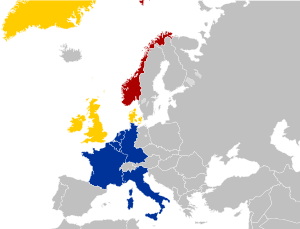Treaty of Accession 1972
| |
|---|---|
|
Countries involved in the treaty, with newly joining countries in yellow, countries who failed to join in red, and existing EC countries in blue. | |
| Signed | 22 January 1972 |
| Location | Brussels |
| Effective | 1 January 1973 |
| Condition | ratification by Denmark, Ireland, Norway, the United Kingdom and all 6 Member States of the European Union |
| Signatories | 10 |
| Ratifiers |
9 / 10 |
| Depositary | Government of the Italian Republic |
| Languages | All 4 official Languages of the European Union, Danish, English, Irish and Norwegian |
The Treaty of Accession 1972 was the international agreement which provided for the accession of Denmark, Ireland, Norway and the United Kingdom to the European Communities. Norway did not ratify the treaty after it was rejected in a referendum held in September 1972. The treaty was ratified by the Denmark, Ireland and the United Kingdom who became EC member states on 1 January 1973 when the treaty entered into force. The treaty remains an integral part of the constitutional basis of the European Union.
Full title
The full official name of the treaty is:
Treaty between the Kingdom of Belgium, the Federal Republic of Germany, the French Republic, the Italian Republic, the Grand Duchy of Luxembourg, the Kingdom of the Netherlands (Member States of the European Communities) the Kingdom of Denmark, Ireland, the Kingdom of Norway and the United Kingdom of Great Britain and Northern Ireland concerning the accession of the Kingdom of Denmark, Ireland, the Kingdom of Norway and the United Kingdom of Great Britain and Northern Ireland to the European Economic Community and to the European Atomic Energy Community.
Context
The four countries were already economically linked within the European Free Trade Area. The UK's role in international affairs had weakened, unlike the EEC member countries, which in the 1960s were strongly recovering from the Second World War; Ireland remained economically dependent on the latter, which represents nearly 75% of its exports[1] and sought to reduce this dependence.
To join the EEC, countries had to meet two criteria: belonging to the European continent and obtain agreement from all member countries. On 31 July 1961 the United Kingdom,[2] Ireland[3] and Denmark[4] applied to join the EEC. In 1963, after lengthy negotiations,[5] France vetoed Britain's application because of the aversion to Charles de Gaulle to the UK,[3] which he considered a "Trojan Horse" for the United States.[1] De Gaulle famously uttered the single word 'non' into the television cameras at the critical moment, a statement used to sum up French opposition towards Britain for many years afterwards.[6][7] UK Prime Minister Harold Macmillan said afterwards that he always believed that de Gaulle would prevent Britain joining, but thought he would do it quietly, behind the scenes. He later complained privately that "all our plans are in tatters".[8]
Enlargement
France, under de Gaulle's successor Georges Pompidou, removed its opposition following the 1969 Hague EEC summit conference.[9] This made the expansion of membership possible, providing for political convergence between the EEC and EFTA.
After a long period of negotiations, expansion of the EEC's membership was ratified by the member states' national parliaments, except in France where in April 1972 a referendum on EEC enlargement was passed with a favorable vote of 68%.[1]
Between May and October 1972, the treaty was passed in three EFTA states; in Ireland on May 10, 1972, with 81.3% of the vote; in the UK by the Houses of Parliament; and in Denmark with 63.3% of votes; the Danish Constitution provides for submit to the public any changes that may cause a change in the sovereignty of the country.[10] Norway's referendum however, was a defeat for expansion, with 53.5% of voters opposed. Prime Minister Trygve Bratteli resigned following the defeat of his government. It was the second attempt by Norway to become a member, after being rejected by France in 1962 and again temporarily in 1967, but the first attempt at a referendum following a successful negotiation.[11]
The UK consulted its citizens directly only after entry into the European Economic Community. The UK conducted a referendum on June 5, 1975. The "yes" vote won by 67.23%; this election was held following the British general election of October 1974, the Labour Party government of Harold Wilson held the election to fulfill one of its campaign promises.[12]
See also
- Enlargement of the European Union
- Norway–European Union relations
- Danish European Communities membership referendum, 1972
- United Kingdom European Communities membership referendum, 1975
- Third Amendment of the Constitution of Ireland
References
- 1 2 3 "1er élargissement de la CEE (1er Janvier 1973)".
- ↑ "Address given by Harold Macmillan on the United Kingdom's application for membership to the EC" (PDF). Le Centre Virtuel de la Connaissance sur l'Europe. 31 July 1961.
- 1 2 "Ireland in the EU - Joining the European Community". European Union.
- ↑ "A timeline of the EU". BBC News.
- ↑ "Britain's EU membership: New insight from economic history". VOX, CEPR’s Policy Portal.
- ↑ "BBC ON THIS DAY - 27 - 1967: De Gaulle says 'non' to Britain - again".
- ↑ Richards, Denis & Quick, Antony (1974) Twentieth Century Britain
- ↑ Holland, Robert (1991) Fontana History of England – Britain & the World Role
- ↑ "Final communiqué of the Hague Summit" (PDF). Le Centre Virtuel de la Connaissance sur l'Europe. 2 December 1969.
- ↑ "Danmarkshistorien: Ja til EF 1972". Undervisningsministeriet (Education Ministry).
- ↑ "Folkeavstemningen om EU (opphørt) - SSB". ssb.no.
- ↑ Jan-Henrik Meyer, The 1975 referendum on Britain's continued membership in the EEC, at the site Centre virtuel de la connaissance sur l'Europe.

